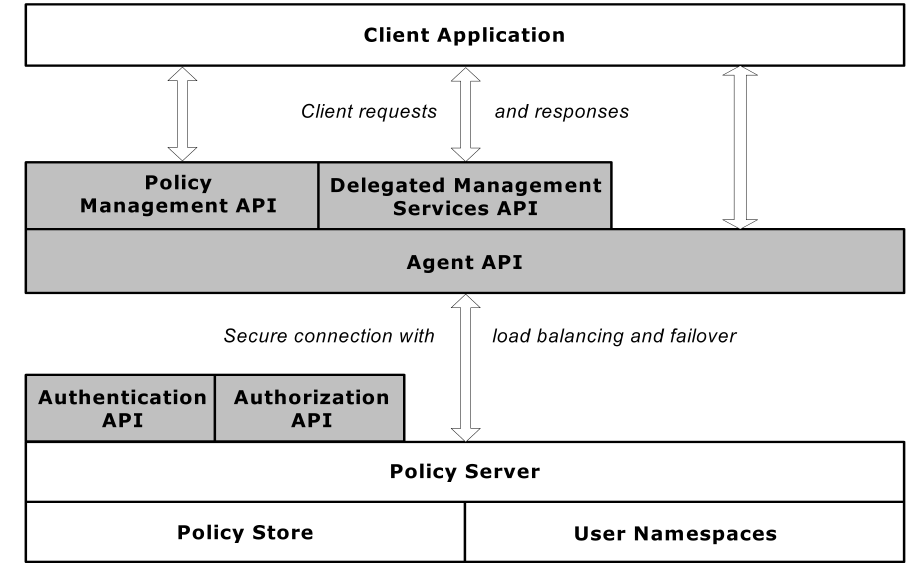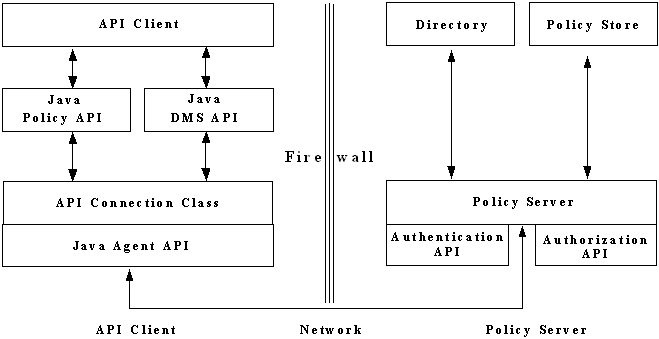

This section contains the following topics:
Java Components of the SiteMinder SDK
Delegated Management Services API
How Java Components Fit Together
The SiteMinder SDK provides Java APIs for performing the following tasks:
The Java APIs, documentation, and samples are installed to the following location:
<install_path> refers to the installation path where you installed the SDK software.
The SiteMinder SDK includes tested samples of SiteMinder client applications. The source files for these samples are located as follows:
<install_path>/sdk/samples/<api-name>
<install_path>\sdk\samples\<api-name>
Notes on the Java samples:
You must have the SiteMinder Policy Server to run the applications and Policy Server plug-ins that you develop with the SiteMinder SDK. However, in most cases, you do not use the Policy Server to build those applications and plug-ins. The application runtime files can either be local or remote to the Policy Server.
The Java components of the SiteMinder SDK are listed in the following table:
|
API Name: Package Name |
Primary Interfaces and Classes |
|---|---|
|
Java Agent API: netegrity.siteminder.javaagent |
AgentAPI |
|
Policy Management API: com.netegrity.sdk.policyapi |
SmPolicyApi, implemented by SmPolicyApiImpl |
|
Authentication and Authorization APIs com.netegrity.policyserver.smapi |
SmAuthScheme ActiveExpression |
|
Delegated Management Services API: com.netegrity.sdk.dmsapi |
SmDmsApi, implemented by SmDmsApiImpl |
|
Utilities package: com.netegrity.sdk.apiutil |
SmApiConnection SmApiSession |
Use the Java Agent API to build a custom agent for enforcing access control and for managing user sessions. Enforcing access control consists of the following:
When using the Java Agent API, code your agent in Java. The Agent API performs the connection to the Policy Server.
The SiteMinder Java Agent API has two implementations:
Because there are no native-mode components, the pure Java Agent API is highly portable to new operating environments. Applications written using the pure Java implementation require certification only against the Java Virtual Machine hosting the implementation, rather than against individual operating systems.
Use the Policy Management API to manage the following SiteMinder elements:
You can manage policies by creating, deleting, associating, and modifying policy objects such as policy domains, realms, and policies.
Use the Authentication API to create a custom authentication scheme that implements authentication service not offered by any of the standard SiteMinder authentication schemes.
Use the Authorization API to implement custom functionality for controlling access to protected resources. The functionality is provided through custom Java classes that are referenced in Policy Server active expressions. An active expression is a string of variable definitions that appears in the following Policy Server objects:
Use the Delegated Management Services (DMS) API to perform tasks such as:
Use the methods in the Utilities package to implement the APIs in the Policy Management API and the DMS API.
The following figure shows how the Java components of the SiteMinder SDK fit together:

You can use the Java APIs to write client applications that connect to a remote SiteMinder Policy Server. These applications have access to the following built-in functionality of the Java Agent API:
The network architecture of the Java APIs is shown in the following figure:

The Policy Management API and the DMS API use the Java Agent API to access the Policy Server. A single API client instance makes a single, secure, Agent API connection to the SiteMinder Policy Server. As long as they share the same process space, multiple API clients can use a single Agent API connection. For example, you can use the Java Agent API to establish a connection, then use that connection to make DMS API calls.
The steps listed following are required when you are creating a client application with the Policy Management API or the DMS API:
To establish a connection to the Policy Server, use the SmApiConnection class of the Utilities package. This class holds the Agent API handle through which Java API requests are sent.
There are two types of connection handles in this class:
You can establish multiple connections to the Policy Server through the single Agent API object instance.
If you have not already established a connection to the Policy Server, you can request an automatic connection. If SiteMinder establishes a connection for you automatically, it creates a default Java Agent API object and handle. However, if a valid user-defined handle already exists, SiteMinder does not create a default object and handle. A user-defined handle takes precedence over a default handle.
To establish a default connection to the Policy Server automatically
SmApiConnection (boolean bDefaultAgentConnection boolean disableLoadBalancing)
SmApiConnection m_defaultConnection = new SmApiConnection(true,false);
An automatic connection has the following requirements:
You establish a user-defined connection in one of two ways:
Note: If you already have a connection to the Policy Server, you can use it to make subsequent Policy Management API or DMS API calls.
To create a connection using an existing Agent API connection
SmApiConnection (netegrity.siteminder.javaagent.AgentAPI agentApiConnection)
SmApiConnection myConnection = new SmApiConnection (myAgentApiConnection);
The new Java Agent API handle is a user-defined handle.
If you do not already have a default connection and you want a user-defined connection object, you can use the Agent API to create the agent object and then create the new connection, as follows:
You can create an agent object based on connection parameters from either of the following sources:
AgentAPI agent = new AgentAPI(); ServerDef sd = new ServerDef(); sd.serverIpAddress = POLICY_IP; sd.connectionMin = CX_MIN; sd.connectionMax = CX_MAX; sd.connectionStep = CX_STEP; sd.timeout = CX_TIMEOUT; sd.authorizationPort = AZ_PORT; sd.authenticationPort = AUTH_PORT; sd.accountingPort = ACC_PORT; InitDef init=new InitDef(AGENT_LOGIN,SHARED_SECRET,false, sd); agent.init(init);
Note: With SiteMinder v6.0 and later, the authorization, authentication, and accounting servers are combined into a single server process. Consequently, authorizationPort, authenticationPort, and accountingPort can all be set to the same value.
Note: SiteMider v4.x webagent.conf files are no longer supported by the SM API.
After creating the agent object, you create the new connection in either of these ways:
SmApiConnection myConnection = new SmApiConnection(agent);
SmApiConnection myConnection=new SmApiConnection(false,false); myConnection.setAgentApiConnection(agent);
If you establish the connection in this way, the Java Agent API handle is a user-defined handle.
If you call setAgentApiConnection() and you do not have a connection, you can establish an automatic, static connection by passing in null.
After you obtain a connection to the Policy Server, get a user or administrator session.
Note: To use the Policy Management API, you must connect as a SiteMinder Administrator.
After you obtain a session object, pass it to the Policy Management API or the DMS API through the constructor for the SmPolicyApiImpl class, or the SmDmsApiImpl class.
To obtain a session, perform one of these actions:
|
If... |
And... |
Then... |
|---|---|---|
|
You have an existing session from authenticating a user. |
— |
Pass in the session specification for the authenticated user. |
|
You do not have an existing session. |
You must connect as a SiteMinder Administrator. |
Use the method SmApiSession.login(). |
|
You do not have an existing session. |
You want to connect as a non-Administrator. |
Use the Java Agent API to obtain a session specification for the user. |
If you have a session specification for a user that has been authenticated, you can use that session specification. You need not obtain a new session specification.
To use an existing session, create an SmApiSession object and associate the session specification with that object.
To authenticate a SiteMinder administrator, use the login() method in the SmApiSession class of the Utilities package. This method uses the administrator’s login credentials (username and password) to authenticate the administrator. Calling this login() method obtains a session specification and returns an SmApiResult object.
The syntax of the login() method is as follows:
result=mySession.login (username, password, IPaddress, challengeReason);
Provide a value for the challengeReason parameter as follows:
To retrieve the reason value to assign to challengeReason, call getReason() in the SmApiResult object.
To obtain a new session specification for a user, use the Java Agent API to obtain a session specification. Then, create an SmApiSession object and associate the session specification with that object.
Agent discovery lets CA SiteMinder® administrators track instances of different types of agents, including agents that have been deployed over a number of years. An agent instance can be any type of agent, for example, Web agent, custom agent, or ERP agent. To come under the purview of agent discovery, the agent must be active and in communication with the Policy Server.
Only 5.x agents and later can be tracked. For agents created before r12.5, the combination of the IP address and trusted host are used to identify the agent. Any change in this combination for the same agent results in multiple entries for the same agent.
A unique GUID identifies each r12.5 agent instance, which is stored in a configuration file. Multiple agent instances cannot share a configuration file. In addition to the location of the configuration file, AgentInstanceDef.java defines parameters that specify the following attributes of an agent instance:
When you want a custom agent to come under the purview of agent discovery, follow this process:
If this method returns a valid configuration path, the agent instance is already accounted for in the agent discovery process.
The agent instance periodically sends the Policy Server a heartbeat message informing the Policy Server that the agent instance is still active.
After you establish a session, you can call the methods in your client application.
A result is a response from the Policy Server to a Java API request. Results are returned in an SmApiResult object.
Exceptions are thrown from an unexpected client-side error. An exception contains a result with additional information, such as the origin and severity of the result. To create a result object to store the results of API requests, use the constructor of the SmApiResult class in the Utilities package—for example:
SmApiResult result = new SmApiResult();
You can verify whether a request was successful by calling the method isSuccess() on the result object. The method returns true if the request was successful, or false if it was not successful.
You can compare the current result object to a specified result object by calling the equals() method.
You can use the equals() method to compare the current result object with SmApiResult constants that represent different kinds of results. For example, in the following code, the result represented by the unique constant SERVER_INVALID_PASSWORD is compared against the current result object:
InetAddress address = InetAddress.getLocalHost(); SmApiResult result = apiSession.login(usr,pwd,address,0); boolean resultStatus = result.equals(SmApiResult.SERVER_INVALID_PASSWORD);
To log tracing information on the client side, use the -D option of the java tool and set the system property SMJAVASDK_LOG_INFO to true. SiteMinder logs the information to the standard output.
For example, if your Java Development Kit is on Windows and you want to trace the Policy Management API sample application, the command line would be:
java -DSMJAVASDK_LOG_INFO=true -classpath .;..\..\java\smjavasdk2.jar; ..\..\java\smjavaagentapi.jar PolicyApiSample
Use the Javadoc to learn about a particular class or method. These details typically include syntax, parameters, return values, and exception information.
The description of each package, class, and interface in the Javadoc reference sometimes includes a Since heading that indicates the SiteMinder or SDK version when the component was introduced. Individual methods and fields only include a Since heading if they were added in a later version of the class or interface.
CA supports the Software Development Kit (SDK) as part of the standard offerings. Code written by customers or partners, however, is not supported. You are responsible for the code you write. If you require assistance designing or implementing SDK-based code, contact your CA customer account team.
|
Copyright © 2014 CA.
All rights reserved.
|
|